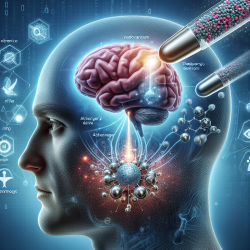Introduction
Alzheimer's disease (AD) is a progressive neurodegenerative disorder characterized by cognitive decline and memory loss. Traditional treatment methods, including oral and parenteral routes, face challenges such as low bioavailability and limited brain penetration. This has led to an increased interest in alternative delivery methods, particularly intranasal delivery, which offers a direct route to the brain via the olfactory and trigeminal pathways.
Nanotechnology: A Game Changer
Recent advancements in nanotechnology have revolutionized the approach to drug delivery for Alzheimer's disease. Nanocarriers, such as polymeric nanoparticles, lipid-based carriers, and metal nanoparticles, offer unique advantages, including enhanced bioavailability, targeted delivery, and improved drug stability. These carriers can traverse the blood-brain barrier (BBB), a significant hurdle in CNS drug delivery, thus increasing therapeutic efficacy.
Intranasal Delivery: Direct Brain Targeting
Intranasal delivery bypasses the BBB, providing a non-invasive and efficient route for drug administration. The nasal cavity's rich vascularization facilitates rapid absorption, reducing systemic exposure and potential side effects. Nanocarriers enhance this delivery method by improving drug solubility and stability, ensuring sustained release and prolonged retention in the brain.
Types of Nanocarriers
- Polymeric Nanoparticles: These offer controlled release and can be engineered to target specific brain regions. Functionalization with ligands enhances receptor-mediated uptake.
- Lipid-Based Nanocarriers: Solid lipid nanoparticles (SLNs) and nanostructured lipid carriers (NLCs) provide a biocompatible matrix for drug delivery, improving solubility and permeability.
- Metal Nanoparticles: Gold and iron nanoparticles have shown promise in theragnostic applications, offering both therapeutic and diagnostic capabilities.
Challenges and Considerations
While nanotechnology offers significant potential, challenges remain. Regulatory hurdles, toxicity concerns, and the need for extensive characterization of nanocarriers are critical considerations. The scalability of production and cost-effectiveness are also pivotal for clinical translation.
Future Directions
The future of Alzheimer's treatment lies in personalized medicine, where nanocarriers can be tailored to individual patient needs. The integration of diagnostic and therapeutic functions into a single nanocarrier system (theranostics) could provide real-time monitoring of treatment efficacy. Collaborative efforts among researchers, clinicians, and regulatory bodies are essential to overcome current challenges and harness the full potential of nanotechnology in Alzheimer's management.
To read the original research paper, please follow this link: Intranasal Drug Delivery by Nanotechnology: Advances in and Challenges for Alzheimer’s Disease Management.










